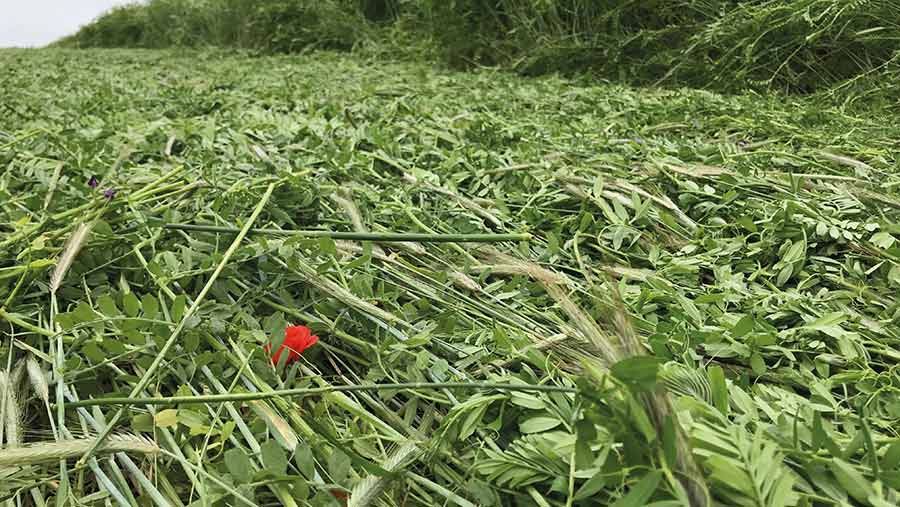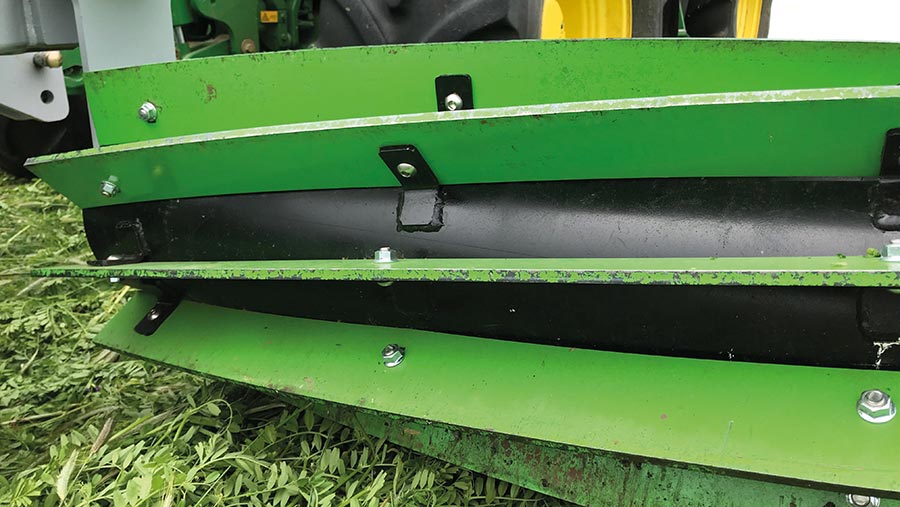How to achieve the most effective cover crop destruction
 © Tim Scrivener
© Tim Scrivener Cover crops are becoming a mainstream option for growers, but their successful destruction ahead of spring cropping is greatly dependent on the type of cover species sown, timing and removal method.
As covers establish throughout the winter, they retain available nutrients, improve soil condition and provide the host for a range of soil biology, but attention then turns to their effective removal.
A range of methods are used to achieve this: chemical, mechanical and grazing of livestock – but a combined approach can offer an effective solution.
We speak to two advisers to find out what growers should consider when it comes to achieving the most effective cover crop destruction.
See also: Liquid digestate and min-till help farm get to carbon neutral
Destruction dates
Firstly, Richard Barnes, sales manager at seed specialist Kings Crops – a division of Frontier Agriculture – recommends checking if crops are tied in to any environmental schemes before they are removed, as this can restrict the dates for their destruction.
The Countryside Stewardship Winter Cover Crop option (SW6) states covers are to be destroyed in late January or February before they are too well developed, while in Scottish ecological focus areas (EFA) covers are permitted for destruction/grazing from 1 January onwards.
“Growers with cover crops grown as part of a water company initiative should also check destruction timings with their local company,” he says.
Glyphosate
In most situations, the application of glyphosate will deliver an effective removal of sown cover crops and is beneficial for addressing grassweeds. However, the correct spray rate, timing and quality is critical to get an effective kill.
Mr Barnes advises growers to be mindful of the lead time of glyphosate before drilling, as this varies depending on soil type, weather conditions and the length of time the soil has been in cover cropping.
“Land in its first year of covers will usually need a longer lead time to help create the best medium to drill the following crop into,” notes Mr Barnes.
Bayer Roundup technical specialist Tom Scanlon adds that when it comes to spraying with glyphosate, growers need to get it right first time.
“Unless drilling straight into green cover, allow four to six weeks ahead of spring sowing for what can be a large amount of biomass to die back,” he says.
This ensures the active has enough time to break down the crop canopy and any weed species, which can otherwise cause a delayed and uneven crop establishment.
Rates
Mr Scanlon advises a rate of 1,080g/ha of glyphosate for easier-to-manage covers ahead of spring drilling, while rates can be dropped back to 720g/ha in the autumn.
“Glyphosate rates should be suited to the hardest-to-kill species in the mix. Employ rates of up to 1,440g/ha for most brassicas other than mustard, while a full 1,800g/ha will be necessary for most legumes, other than spring vetch and autumn-treated lucerne.”
However, he notes that these rates only apply to modern Roundups as they are proven to work much better than other non-tallow amine formulations, getting glyphosate into plants more rapidly and reliably at low temperatures. “Less active formulations may require a different approach.”
When glyphosate is used in conjunction with other removal methods such as grazing, rolling or flailing, rates can be cut back to an appropriate dose.
Where there is a high pressure of weed growth, the addition of 2,4D to the mix can be beneficial. But it’s important to check the label and speak to your agronomist as withdrawal periods for following crops vary and the rate of inclusion is important to avoid potential antagonism.
In bigger crops you may need to “open up” the canopy by using a cafentrazone spray ahead of glyphosate, to ensure good coverage of smaller plants.
For the most effective penetration of tall, thick, multi-species canopies, a spray quality on the coarser side of medium with flat fan nozzles at less than 2.5 bar, is recommended.
“Increasing water volumes from 100 to 150 litres/ha will also give better coverage of larger, thicker canopies. And angling the nozzles alternately straight down and 30deg forward will improve penetration,” says Mr Scanlon.
Cover crop controllability with glyphosate applied at three different timings |
|||
| Cover crop | Autumn | Early spring | Mid spring |
| Winter oats | Green | Green | Green |
| Winter rye | Green | Green | Green |
| Triticale | Green | Green | Green |
| Westerwolds | Green | Green | Green |
| Buckwheat | Green | Green | Green |
| Yellow trefoil | Amber | Red | Red |
| Sanfoin | Amber | Red | Red |
| Winter vetch | Red | Amber | Red |
| Spring vetch | Amber | Amber | Amber |
| Lucerne | Green | Amber | Red |
| Berseem clover | Green | Green | n/a |
| Mustard | Green | Green | Green |
| Phacelia | Green | Green | Green |
| Chicory | Green | Amber | Amber |
| Borage | Green | Green | Green |
| Rocket | Amber | Green | Green |
| Leafy turnip | Amber | Green | Amber |
| Oil Radish | Amber | Green | Amber |
| Daikon tillage radish | Amber | Green | Green |
| Smart radish | Amber | Green | Green |
| Linseed | Green | Green | Green |
| Stubble turnips | Amber | Green | Amber |
|
Source: Bayer, trial carried out using Roundup. Key: Green – apply, Amber – use caution, Red – avoid |
|||
Grazing
As the cost of glyphosate has more than doubled in recent months and growers are aiming to reduce reliance on chemical inputs, an integrated approach can provide opportunity to cut back rates.
Grazing cover crops with livestock is now a popular option. It successfully removes biomass, generates an additional income and recycles nutrients into readily available forms.
However, Mr Barnes warns that success is often dependent on soil type and ground conditions.
“Grazing on medium-to-light soils is recommended, while heavier soils should be avoided as poaching can soon undo work done by the cover and cause a solid cap to form on the soil surface.”
Ideally, sheep should have a flying visit with just a light graze to remove biomass. Then the crop should re-grow for 10-to-14 days, before spraying with glyphosate at the required rate.
This creates an even target coverage and effectively clears up any brome and blackgrass regrowth, setting up the seedbed for spring-sown crops.
Another important factor to note with livestock grazing, says Mr Barnes, is the need to prepare a livestock manure nitrogen farm limit and crop nutrient plan.

© Lucinda Dann
Frosts and rolling
Identifying the species present within a cover crop mix is key to effective removal, he continues, since some species are more susceptible to frost than others.
“Frost-sensitive species such as buckwheat, berseem clover or mustard, are particularly susceptible to hard frosts, which provide a reasonable job of crop destruction.
“However, more robust, winter-hardy species such as vetch, cereals, linseed and radish are more tolerant to freezing temperatures and therefore require specific attention.”
Rolling or crimping can be used in conjunction with hard frosts to enhance cover crop removal, which has seen growers out at the crack of dawn with rollers on the frozen surfaces.
When crops are flattened, their stems break at the growing point, exposing crops to the freezing temperatures, causing them to die. The use of a crimper roller provides a more aggressive roll to macerate the crop and achieve an effective destruction.
Mr Barnes reminds growers that crimping/rolling will not fully deal with the cover crop or weed destruction alone and, therefore, requires use of another method alongside, commonly a lower rate glyphosate spray.
“Aim to destroy 65-70% of the crop with the rolls when it’s frosty and remove the rest with a reduced rate of glyphosate.”
He also highlights the importance of considering any impact on ground roosting bird species such as grey partridge, ahead of rolling or crimping cover crops during the early morning hours of darkness.
Flailing
Flailing offers an effective method of removing big bulky crops, with woody stems that cannot be easily grazed.
However, this is a very intensive process, requiring high levels of diesel and labour, not to mention additional wheelings. “This method has its place, but comes at an extra cost,” says Mr Barnes.
Deep inversion
Deep inversion with a plough or other deep cultivator may be the preference for some and has its place in certain systems such as removing covers ahead of root crops such as sugar beet or potatoes, or in organic systems.
However, this process may not suit all, as it goes against the principle of minimising soil movement to maintain and improve soil biology.
22 cover crop species
Four years of trial work investigating the efficacy of glyphosate on the destruction of a range of catch and cover crops has highlighted how difficult a number of species are to destroy, and provided growers with reliable guidance on their management.
The research, conducted by Bayer Crop Science alongside Pearce Seeds at their Sturminster Newton trials site on the Somerset/Dorset border involved spraying 22 of the most widely used covers with glyphosate applied in the autumn, early and mid-spring.
“This work allowed us to develop traffic light guidance for catch and cover crops, to help growers manage them as effectively as possible.
“Regardless of how well they established or the severity of the winter, we consistently found some species much harder to destroy than others,” explains Roundup technical specialist, Tom Scanlon.
The trial showed phacelia, buckwheat and mustard readily succumb to colder weather.
Providing that spraying was not left until the onset of stem extension during the spring, Mr Scanlon says cereal components in cover mixes did not present much of a challenge either.
The biggest issue, however, lies with legumes as a number of cover species are particularly difficult to control in the spring, even with the most effective glyphosate treatment.
Yellow trefoil, sainfoin and winter vetch are the worst offenders here, stresses Mr Scanlon.
“They put serious pressure on glyphosate at a time of the year when low temperatures restrict herbicide uptake and translocation.
As well as taking much longer than other species to die back, they have shown appreciable regrowth long after treatment in many cases.
Spring vetch poses less of a problem, but is still a challenge to deal with, while lucerne becomes progressively harder to destroy over the winter and into the spring.
When it comes to brassica species, vigorous early winter growth often makes them difficult to destroy in the autumn.
They may also prove more problematic after a hard winter has left their leaves waxy.

